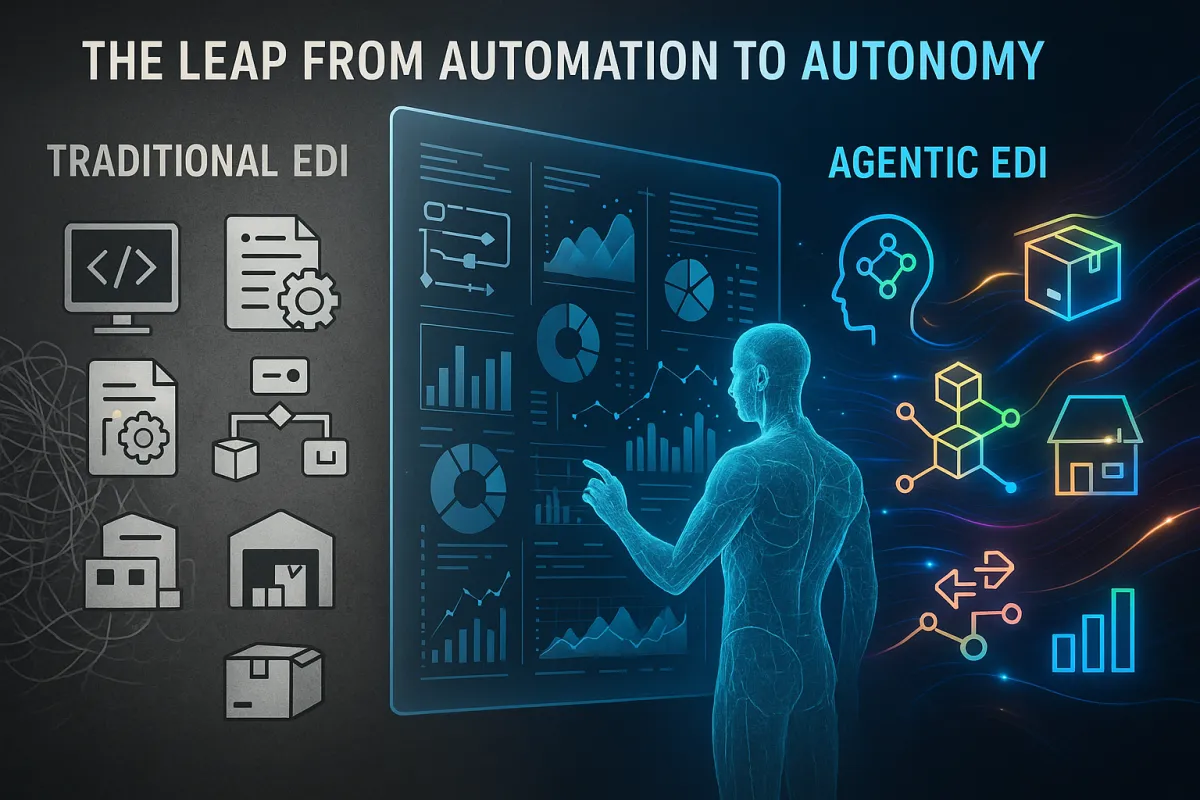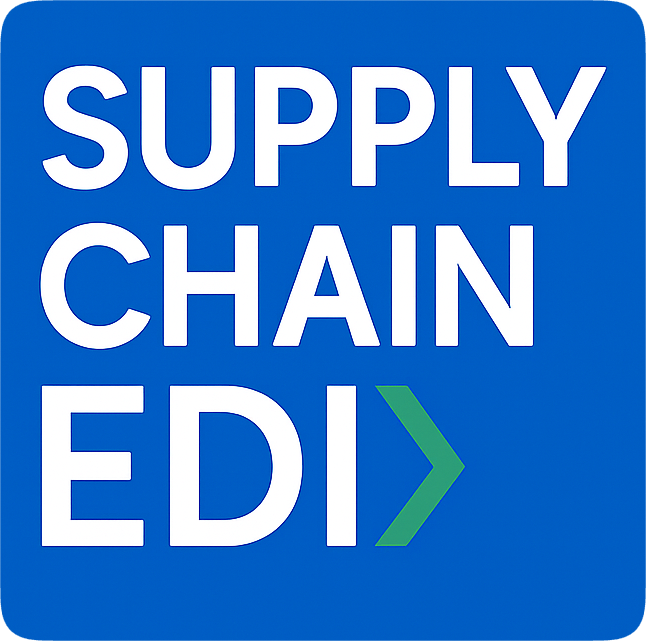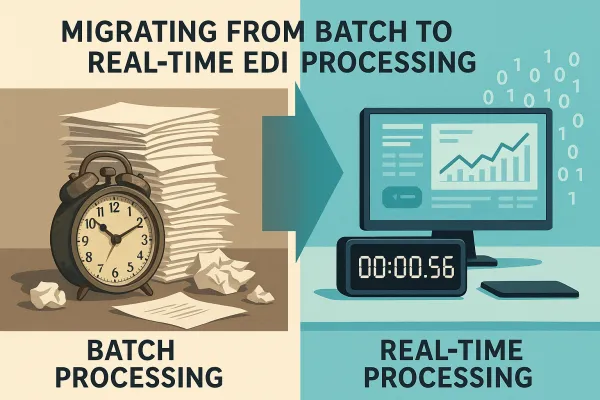The Agentic EDI Implementation Roadmap: Overcoming the 5 Critical Barriers to Autonomous Supply Chain Data Exchange in 2025

The transformation from traditional EDI to agentic EDI implementation isn't just another technology upgrade—it's becoming a strategic imperative that separates competitive organizations from those stuck in reactive, manual troubleshooting cycles. Agentic EDI refers to the integration of autonomous AI agents into EDI systems, enabling them to not only exchange structured data but also interpret, act on, and optimize that data in real time.
Unlike the rigid, rule-based EDI systems that have anchored supply chains for decades, agentic EDI represents a leap from automation to autonomy. It's not just about reducing manual effort—it's about enabling resilient, intelligent, and proactive operations. For EDI managers dealing with 31+ billion annual transactions containing trillions of data points, this isn't theoretical—it's the difference between drowning in exceptions and orchestrating intelligent responses to supply chain disruptions.
Understanding Agentic EDI: The Next Evolution Beyond Traditional Automation
Traditional EDI automation handles predefined workflows and responds to specific triggers. You set rules, map data fields, and hope your exception handling covers the edge cases. Agentic EDI operates differently. These systems gain intelligent EDI agents that proactively resolve issues, adapt to shifting demands, and free up their teams to focus on higher-value work—not manual troubleshooting.
The key capabilities that distinguish agentic AI EDI implementation from traditional automation include real-time data interpretation across multiple transaction types, autonomous decision-making for supplier compliance issues, and dynamic optimization of processing workflows based on current conditions. While your existing EDI system might flag a missing ASN, an agentic system would analyze historical patterns, contact the supplier through multiple channels, and potentially adjust downstream logistics planning—all without human intervention.
The strategic value becomes clear when you consider supply chain resilience. Gartner predicts that by 2030, 50% of cross-functional supply chain management (SCM) solutions will use intelligent agents to autonomously execute decisions in the ecosystem. Organizations implementing these systems now position themselves ahead of this curve, building competitive moats through advanced TMS integrations and autonomous EDI operations that competitors struggle to replicate.
The Reality Check: Why 86% of Agentic AI Initiatives Are Stalling
Here's what most implementation guides won't tell you: only 14% of senior leaders report agentic AI technology has been fully implemented in their organization. Even more concerning, about nine-in-ten (87%) report there are barriers to agentic AI adoption in their organization despite massive investments in AI infrastructure.
According to nearly 60% of the AI leaders and representatives surveyed, their organization's primary challenges in adopting agentic AI are integrating with legacy systems and addressing risk and compliance concerns. These top barriers were followed closely by lack of technical expertise. For EDI managers, this translates directly to the reality of connecting autonomous EDI systems with decades-old ERP systems, transport management platforms, and established supplier networks.
The gap between expectation and execution reveals a fundamental misunderstanding of what agentic AI implementation requires. Most organizations aren't agent-ready. Your existing EDI infrastructure, built for predictable data flows and manual oversight, needs substantial architectural changes to support autonomous decision-making agents.
About 90 percent of transformative "vertical" (function-specific) use cases remain stuck in pilot mode because organizations underestimate the technical, organizational, data, and cultural barriers that prevent scaling from proof-of-concept to production deployment. This pattern holds particularly true for EDI implementations where legacy system dependencies run deep.
Barrier #1: Legacy System Integration - The Infrastructure Challenge
The infrastructure challenge hits EDI operations harder than most business functions because your systems weren't designed for autonomous agents. The most significant challenge according to AI leaders, cited by 35% of respondents, is infrastructure integration. Your existing EDI translation software, ERP connections, and partner communication protocols create a complex web that agentic AI must navigate without breaking established workflows.
Legacy systems often store data in incompatible formats, making integration complex and expensive. Consider what happens when an agentic EDI system needs to access real-time inventory data from a 15-year-old warehouse management system, cross-reference supplier performance metrics stored in disparate databases, and integrate with modern TMS platforms like MercuryGate, Manhattan Active, or Cargoson simultaneously.
The practical solutions require a phased modernization approach. Start with API-first middleware that creates abstraction layers between your agentic systems and legacy EDI infrastructure. This allows agents to access necessary data without requiring complete system replacements. Gradual migration strategies work better than big-bang implementations—deploy agentic capabilities for specific transaction types (like ASN processing or invoice matching) before expanding to full supply chain orchestration.
EDI standard upgrades become necessary as agents need richer data context than traditional X12 or EDIFACT transactions provide. Modern implementations often require hybrid approaches that maintain backwards compatibility while enabling enhanced data exchange for autonomous operations.
Barrier #2: Data Quality and Governance - The Foundation Problem
Poor data quality remains a significant technical barrier to AI adoption. Unlike traditional EDI systems that can function with basic data validation, agentic AI requires training data that reflects real-world complexities across your entire supply chain ecosystem. The underlying models need to be trained on realistic, high-quality data — data that reflects the complexities of the real world. This requires continuous iterations, sometimes involving thousands of scenarios, before the model can reliably make critical decisions.
Organizations frequently discover their data is incomplete, inconsistent, or biased when attempting to train AI models. Your EDI transactions might include accurate SKU information but lack the contextual data agentic systems need for intelligent decision-making—supplier reliability scores, seasonal demand patterns, alternative routing options, and carrier performance metrics.
This becomes particularly problematic for agentic systems that require consistent, real-time information to make autonomous decisions effectively. Data streaming platforms become essential infrastructure, enabling continuous data quality validation and real-time updates across your EDI ecosystem. Anonymization protocols protect sensitive supplier and customer information while providing agents with sufficient context for decision-making.
Implementation strategies must address data silos that have accumulated over years of independent EDI partnerships. Quality validation frameworks should continuously monitor data accuracy, completeness, and consistency across carrier connectivity, multi-carrier shipping platforms, and supply chain data sources that feed autonomous EDI agents.
Barrier #3: Security and Compliance - The Trust Framework
Since AI agents often interact with multiple systems and databases, they're likely to have access to sensitive data. Similarly to Generative AI where every piece of data provided to the model gets embedded within the system, Agentic AI could inadvertently expose a business to vulnerabilities, such as data leaks or malicious injections.
For EDI operations handling sensitive supplier contracts, pricing information, and customer data, privacy concerns remain a major barrier to gen AI implementation. Again, data governance and responsible AI principles play a role. Agentic systems accessing multiple ERP systems, TMS platforms, and external partner networks create expanded attack surfaces that traditional EDI security models weren't designed to protect.
Businesses must align their AI usage with global data privacy laws such as GDPR, CCPA and industry-specific regulations. Transportation management systems often handle cross-border shipments subject to customs regulations, adding compliance complexity that autonomous EDI agents must navigate without human oversight.
Implementation strategies require robust data segmentation that isolates sensitive information while providing agents with operational context. Companies can start by isolating data and implementing robust segmentation protocols. Additionally, anonymising sensitive information, such as removing personally identifiable data (like names or addresses), before sending it to the model is key. Comprehensive audit trails track every autonomous decision and data access, essential for compliance reporting and troubleshooting unexpected agent behaviors.
Barrier #4: Skills and Cultural Readiness - The Human Element
A majority (64%) of senior leaders agree that the fear of replacement, as opposed to augmentation, will stifle agentic AI adoption. This cultural barrier affects EDI teams particularly strongly because many professionals built careers on expertise in manual exception handling, partner relationship management, and complex troubleshooting—exactly the areas where agentic systems excel.
Workforce skills and readiness follow closely at 26% among primary adoption barriers. EDI specialists need training on AI-driven workflows, understanding how to collaborate with autonomous agents, and developing skills for higher-level strategic planning rather than tactical problem-solving. The biggest barrier isn't the technology; it's mindset, change readiness and workforce engagement.
Successful implementations require structured training programs that demonstrate how agentic EDI augments rather than replaces human expertise. Change management strategies should emphasize how autonomous transaction processing frees EDI professionals to focus on supplier strategy, network optimization, and business process innovation—areas where human judgment remains essential.
Notably, 46 percent of leaders identify skill gaps in their workforces as a significant barrier to AI adoption. Organizations must invest in upskilling programs that prepare EDI teams for human-AI collaboration models, teaching them to interpret agent recommendations, override autonomous decisions when necessary, and optimize agent performance through better training data and process design.
The Strategic Implementation Framework - Your 90-Day Roadmap
Successful agentic AI EDI implementation requires a structured approach that addresses technical requirements while managing organizational change. This 90-day framework provides practical steps for moving from assessment to production deployment.
Phase 1: Assessment and Foundation (Days 1-30)
Begin with comprehensive evaluation of your existing TMS and EDI infrastructure. Document current data flows, identify integration points with systems from established players like IBM Sterling and SPS Commerce, and assess compatibility requirements for autonomous agents. Map your most frequent exception scenarios—supplier compliance failures, missing shipment notifications, invoice discrepancies—that agentic systems could address autonomously.
Establish baseline metrics for transaction processing times, exception resolution cycles, and manual intervention rates. These benchmarks become essential for measuring autonomous EDI performance improvements. Evaluate data quality across your EDI ecosystem, identifying gaps that require remediation before agent deployment.
Phase 2: Pilot Development (Days 31-60)
Start with specific, high-impact use cases rather than attempting full supply chain automation. Automated supplier credential validation and compliance checking provide excellent starting points because they're contained workflows with clear success criteria. Deploy agentic capabilities for single transaction types—perhaps ASN processing or invoice matching—before expanding scope.
Build integration frameworks that connect your pilot agents with existing EDI infrastructure while maintaining parallel manual processes as fallbacks. Test agent performance against historical data, validating decision-making accuracy and identifying scenarios requiring human oversight. Document agent behaviors and decision logic for compliance auditing.
Phase 3: Scale and Optimize (Days 61-90)
Expand autonomous EDI capabilities to additional workflows based on pilot results. Implement governance frameworks that define agent authority levels, escalation procedures, and performance monitoring. Integrate with broader supply chain systems, potentially including innovative solutions like Cargoson alongside traditional platforms.
Establish continuous improvement processes that use agent performance data to refine decision algorithms and expand autonomous capabilities. Train your EDI team on agent oversight responsibilities and strategic planning focused on network optimization rather than transaction troubleshooting.
Future-Proofing Your EDI Operations: The 2025-2030 Outlook
The trajectory for agentic EDI implementation accelerates significantly over the next five years. Gartner predicts that by 2030, 50% of cross-functional supply chain management (SCM) solutions will use intelligent agents to autonomously execute decisions in the ecosystem. Organizations implementing now gain first-mover advantages that become increasingly difficult for competitors to overcome.
PwC estimates that agentic AI systems could contribute $2.6-4.4 trillion annually to global GDP by 2030, suggesting these technologies may boost world economic output by 3-5%. For EDI operations, this translates to fundamental transformation in how supply chain data exchange functions—from reactive transaction processing to proactive supply chain orchestration.
Strategic positioning requires integration planning with emerging technologies and platforms. While established vendors like IBM Sterling and SPS Commerce continue evolving their agentic capabilities, innovative solutions from companies like Cargoson demonstrate new approaches to autonomous supply chain data management. Your implementation strategy should remain flexible enough to incorporate best-of-breed solutions as the market matures.
Agentic systems will increasingly manage end-to-end business processes with minimal human intervention, from supply chain optimization to customer service delivery and financial analysis. EDI managers who position their organizations at the forefront of this transformation create sustainable competitive advantages through autonomous operations, intelligent exception handling, and strategic data utilization that manual processes cannot match.
The next 18 months represent a critical window for beginning serious agentic EDI implementation. Organizations that move beyond pilot projects to production deployment during this period establish the operational foundations and organizational capabilities needed to compete effectively as autonomous supply chain management becomes the industry standard.





